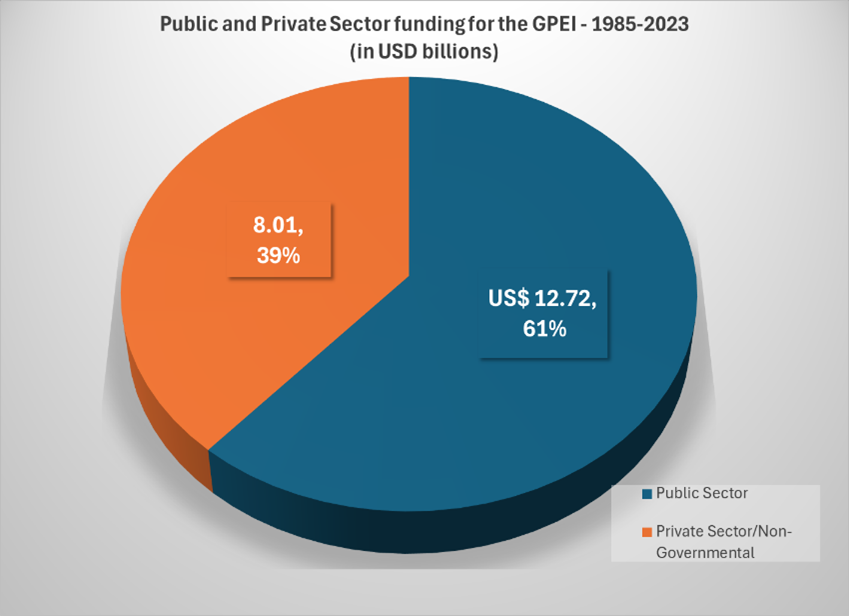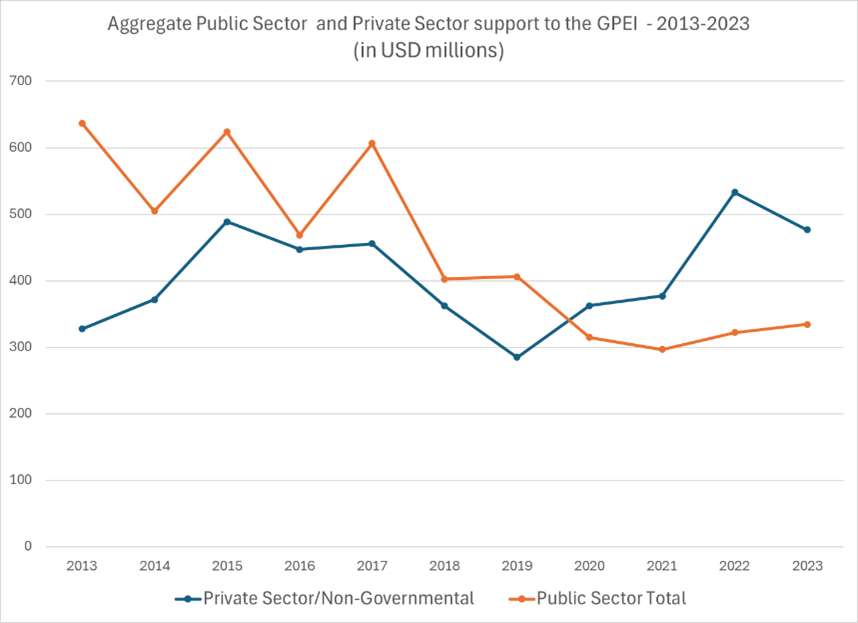Working together for a polio-free world
May. 23, 2025
Rotary International is a core partner of and key donor to the Global Polio Eradication Initiative1 with a cumulative contribution of more than US$2.9 billion and growing, thanks to the generosity and commitment of Rotarians and our partner, the Gates Foundation, which continues to match Rotarian contributions on a two to one basis.
Governments – collectively known as the public sector - also play a vital role in providing funding for the activities of technical agencies. This includes donor governments and national governments who invest their own domestic resources. It also includes the support provided by governments through multilateral institutions like the World Bank and others. Between 1985 and 2023, public sector contributions accounted for US$12.72 billion or 62% of funding for the GPEI. Contributions from the Private Sector and Non-Governmental Organizations, led by Rotary and the Gates Foundation, accounted for just over US$8 billion or 39% of funding provided to the GPEI.

Rotary, through its advocacy with governments, has played – and continues to play – a key role in securing public sector commitments for the GPEI.
However, these high-level figures only tell part of the story. Trends in public sector support over time have been shifting due to a variety of factors ranging from the impact of the COVID-19 pandemic to economic uncertainty affecting specific countries and competing priorities including response to humanitarian crises. This chart shows the trend in public sector and private sector support between 2013 and 2023, the most recent year for which the GPEI has published financial information for contributions.

There will always be competing priorities, and we have an opportunity to remind elected officials that a polio free world remains Rotary’s top priority, is within reach and is a worthy investment.
Progress in the Global Program to Eradicate Polio
· When the Global Polio Eradication Initiative (GPEI) was created in 1988, there were 350,000 annual cases of wild polio in 125 countries. Since then, the global burden of polio has been reduced by 99.9%.
· The GPEI has helped protect over 20 million children from paralysis by reducing polio infections and transmission through vaccination activities.
· Eradication efforts have successfully wiped out two of the three wild poliovirus strains.
· Fewer than 100 cases were recorded in Afghanistan and Pakistan in 2024, the only remaining polio endemic countries where insecurity continues to hamper efforts to reach all children.
· Outbreaks of variant poliovirus, which increased following the pandemic health service disruptions, pose an ongoing challenge to under-immunized communities. However, there were nearly 50% fewer such cases located in fewer geographic areas in 2024 as compared to 2023.
· The GPEI vaccinates more than 370 million children multiple times annually. Every year more than 650,000 children are spared lifelong paralysis thanks to continued polio eradication efforts.
· 2022 saw the first case of paralytic polio in decades in New York state along with detections of poliovirus in waste water in several counties. Polio anywhere is a risk everywhere.
Benefits of Polio Eradication
Since 1985, nearly three billion children have received the oral polio vaccine. Thousands of public health workers have been trained to investigate cases of acute flaccid paralysis and manage massive immunization programs. Cold chain, transport and communications systems for immunization have been strengthened because of the polio eradication initiative.
Polio eradication is helping countries to develop public health and disease surveillance systems useful in the control of other vaccine-preventable infectious diseases. The disease surveillance system--the network of 146 laboratories and trained personnel established for polio eradication – helps track measles, rubella, yellow fever, meningitis, COVID-19, and other deadly infectious diseases. The Acute Flaccid Paralysis (AFP) surveillance system and global laboratory network that supports it will continue to support the surveillance of other diseases long after polio has been eradicated. Immunization campaigns for polio have been used as an opportunity to provide other essential health services such as distribution of essential vitamin A, which has saved the lives of more than 1.25 million children since 1998.
Besides the savings of more than $27 billion in health costs that has resulted from eradication efforts since 1988, investing in polio now may cumulatively save an estimated $33.1 billion by the end of this century when compared to the cost of maintaining the control of polio without eradication. Polio eradication is a cost-effective public health investment, as its benefits accrue forever. On the other hand, as many as 200,000 children could be paralyzed annually in the next 10 years if the world fails to capitalize on the more than $20 billion already invested in eradication.
Our Legacy
In 1985, Rotary made the historic decision to immunize all the world’s children against polio. Today, the world is nearly polio free. With the continued leadership of global governments, civil society, and partner agencies, we will fulfill the promise of a polio free world.
___________
1 Other GPEI partners include WHO, UNICEF, the US Centers for Disease Control and Prevention, Gates Foundation, and Gavi, the Vaccine Alliance.
